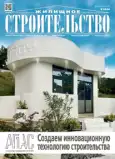A masterpiece of the Leningrad school of constructivism – House of Culture named after Ilyich (Cultural and leisure center «Moscowsky»)
- Authors: Chernyshova E.P.1, Gildina T.A.1, Buryanov3 A.F.2
-
Affiliations:
- The Herzen State Pedagogical University of Russia
- National Research Moscow State University of Civil Engineering
- Issue: No 8 (2024)
- Pages: 35-40
- Section: Articles
- URL: https://ter-arkhiv.ru/0044-4472/article/view/642643
- DOI: https://doi.org/10.31659/0044-4472-2024-8-35-40
- ID: 642643
Cite item
Abstract
Architects of the 1920–1930s acted in the context of the new communist agenda, constructing the spatial environment of the person of the future. The projects of that era realized a dialectical connection between formality (geometricity) and functionality (utilitarianism). Constructivism became the key style of this stage; he was characterized by experiments with volumes, rectangular and curvilinear shapes. House of Culture named after Ilyich, which is the focus of this study, became one of the signs of the time — the era of palaces and houses of culture, where cinemas, concerts, sports, rehearsal halls, libraries, music schools, premises for clubs and circles were located under one roof. The article presents an analysis of the volumetric-spatial solution, the functional characteristics of the building and the history of the existence of the building of the House of Culture, and also identifies the problem of the preservation and restoration of constructivist architecture. In 2020, the House of Culture named after. Ilyich received the status of an object of cultural heritage of the Russian Federation of regional significance. The analysis of the scientific context makes it possible to conclude that today in the scientific community there is an increased attention to avant-garde architecture as a striking phenomenon of Russian architecture and a change in the protective status of the House of Culture building is a positive marker of a change in attitude towards the architecture of the 1920–1930s.
Full Text
About the authors
E. P. Chernyshova
The Herzen State Pedagogical University of Russia
Author for correspondence.
Email: ch-elvira@bk.ru
Candidate of Sciences (Philosophy)
Russian Federation, 48, Embankment of the Moika River, St. Petersburg, 191186T. A. Gildina
The Herzen State Pedagogical University of Russia
Email: felmantanya@gmail.com
Candidate of Sciences (Art History)
Russian Federation, 48, Embankment of the Moika River, St. Petersburg, 191186A. F. Buryanov3
National Research Moscow State University of Civil Engineering
Email: rga-service@mail.ru
Doctor of Sciences (Engineering)
Russian Federation, 26, Yaroslavskoe Highway, Moscow, 129337References
- Petrova E.S. Pamyatniki konstruktivizma v Rossii: katalog-putevoditel’ [Monuments of Constructivism in Russia: catalog guide]. Moscow: Institut Naslediya. 2020. 146 p.
- Lodder Ch. Constructivism: Pragmatic Utopianism. Koinon. 2022. Vol. 3. No. 2, рр. 119–146. https:// doi.org/10.15826/koinon.2022.03.2.020
- Kirikov B.M., Shtiglits M.S. Arkhitektura leningradskogo avangarda: putevoditel’ [Architecture of the Leningrad avant-garde: a guide]. Saint Petersburg: Kolo. 2012. 311 p.
- Smirnov L.N., Bushmina A.V. Architecture of constructivist clubs of Yekaterinburg in the 1920s-1930s. Akademicheskii vestnik UralNIIproekt RAASN. 2015. No. 1, рр. 32–37. (In Russian).
- Sinova I.V. Soviet Houses of Culture as new centers and a form of leisure in the 1930s (based on the materials of the Kirov House of Culture in Leningrad). Social and national in Soviet culture: on the 65th anniversary of the Decade of Tatar Art and Literature in Moscow: a collection of articles based on the materials of the International Scientific Conference, Kazan, October 27–28, 2022. Kazan: Shigabutdin Marjani Institute of History of the Academy of Sciences of the Republic of Tatarstan. 2022, рр. 58–67.
- Dubrovina N.P. Houses of culture of Leningrad. Problems of use and conservation. Urbanistica. 2019. No. 7, рр. 7–17. (In Russian). https://doi.org/10.7256/2310-8673.2019.3.30075
- Lisovsky V.G., Speranskaya V.S., Potapov V.S. From the “Sarskaya road” to the “Victory Avenue”. Stages of formation of the architectural ensemble of Moskovsky Prospekt in St. Petersburg. Bulletin of St. Petersburg University. Art history. 2020. Vol. 10. No. 4, рр. 637–682. (In Russian). https://doi.org/10.21638/spbu15.2020.406
- Dubrovina N.P. Features of the placement of houses and palaces of culture in the buildings of Leningrad in the 1920s and 30s. On the example of the Moskovsko-Narva district. Ekonomika stroitel’stva. 2024. No. 5, рр. 332–335. (In Russian).
- Kakunets K.V. Urban planning features of the spatial organization of the public administrative center of the Moskovsky district in St. Petersburg. Bulletin of the Tomsk State University of Architecture and Civil Engineering. 2020. Vol. 22. No. 3, рр. 85–93. (In Russian). https://doi.org/10.31675/1607-1859-2020-22-3-85-93
- Slavina T.A. Classics and avant-garde. Arkhitekturnoe nasledstvo. 2019. No. 70, рр. 260–272. (In Russian).
Supplementary files









